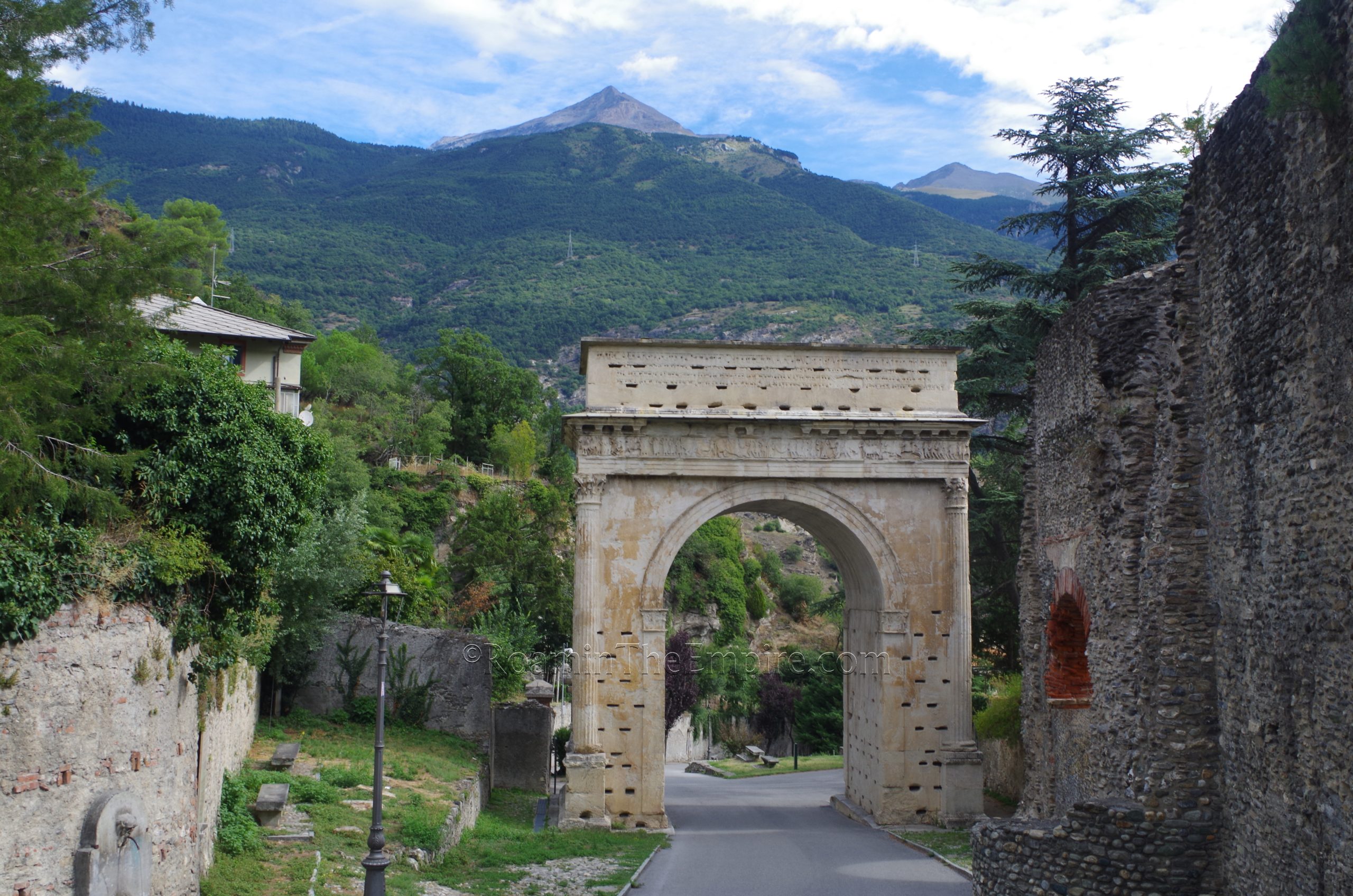
Tucked away among the foothills of the Cottian Alps in Northern Italy, the ancient settlement of Segusium is today located in the Val di Susa, which takes its name from the modern successor of Segusium, Susa. The settlement at the confluence of the modern Cenischia stream and the Dora Riparia (Dura Minor in antiquity) was originally founded by the Celto-Ligurian Segusini, though the exact time frame of the original settlement is unclear. As the naming convention would suggest, Segusium was probably the chief settlement of the Segusini. By the late 1st century BCE, one Marcus Julius Cottius had become chief of the Segusini and during Augustus’ subjugation of other Alpine populations, Cottius negotiated a tributary relationship with Rome, allowing Segusini autonomy and a title for him as praefectus civitatium of 14 towns in the region, referred to by Strabo as the land of Donnus (Cottius’ father) and Cottius.
While under the control of Cottius, the citizens of the region were granted Latin rights. Cottius’ son, who bore the same name as his father, under Claudius was elevated to the rank of king over an area referred to as the Regnum Cottium, which had seemingly been established a bit earlier during the reign of Tiberius. The younger Cottius’ reign as king was short, as a reorganization under Nero in 63 CE abolished the kingship and incorporated the realm into the newly formed province of Alpes Cottiae, which bore the name of the Cottius family and gave rise to the present-day toponym of the region. Segusium would be designated as the capital of Alpes Cottiae.
After Nero’s incorporation into the administration of the Roman Empire, Segusium was granted municipium and the people of Segusium were given the full rights of citizenship. In the latter part of the empire, the passage through the Alps from Italy to Gaul, by way of Segusium seems to have become a prominent and important route. In 312 CE, as Constantine and Maxentius battled for control of the empire, Maxentius posted a force at Segusium in an attempt to block Constantine’s ingress into Italy. When Constantine encountered the town, instead of laying siege to Segusium in a traditional manner, Constantine had his soldiers set the gates of the city alight and quickly assaulted the city by ladder, forcing the surrender of the garrison. A point was made by Constantine to not allow the sack of the city in the aftermath.
Getting There: Susa is not an especially large town, but, it is located in pretty close proximity to Turin, which is a major city in the region and is accessible by rail from other parts of Italy, and by air from Italy and the European Union. I visited via public transport, and the trains between Turin and Susa are pretty straightforward. Trains leave hourly from Turin toward Susa for pretty much the entire day between 5:00 and 22:00. The journey takes a little over an hour and is only 5.40 Euro each way. Return trips between Susa and Torino are similarly hourly. The current schedule should be checked at TrenItalia’s website. Once in Susa, again, the town is pretty small and everything is within walking distance. A personal vehicle is another option, as Susa is about 45 minutes by car from central Turin.
The first stop on the itinerary is actually a site that I was not able to visit on my trip to Susa in 2017, as the area was blocked off for some sort of construction that day. But, in the center of Piazza Savoia are some foundations of a building sometimes described as being a temple, which seems plausible enough given the form of the structure. The remains are in a public area, and though direct access to it is not possible, there’s a small fence enclosing the area, they remains are visible from the street that splits around the excavations. Provided, of course, those streets are not closed down.
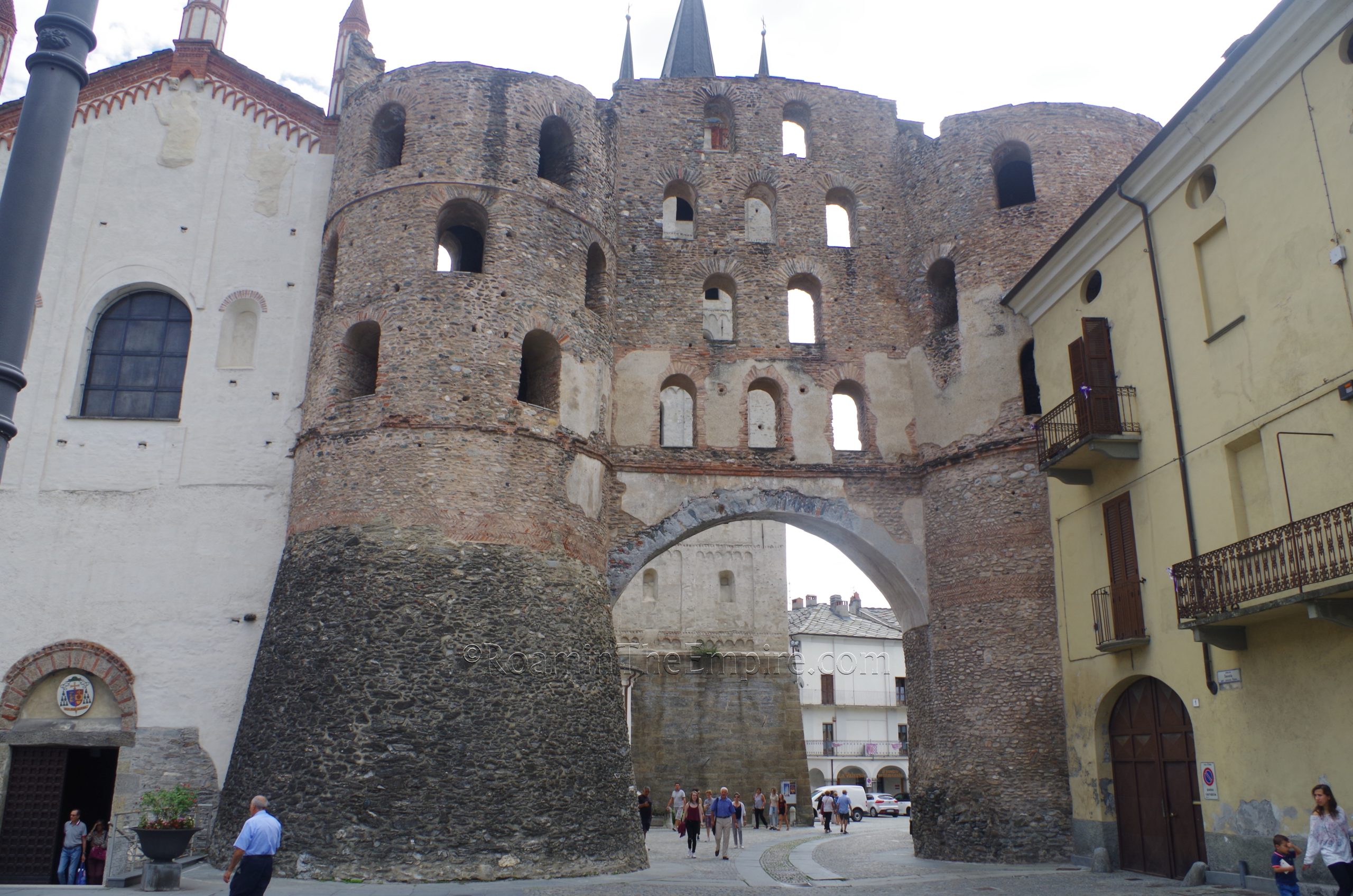
Just a few minutes down the road, though, is the Porta Savoia, the primary northern gate for Segusium. The present-day name for this gate dates to the medieval period, in which it was still in use, when it lead toward the Savoy region. It is also called the Porta del Paradiso, the Gate of Paradise, due to its proximity to the Cattedrale di San Giusto that abuts it. The name the gate was referred to in antiquity is unknown. The Porta Savoia was constructed in the 4th century CE, along with a new circuit of walls, perhaps to replace the wooden gate burned down by Constantine in 312 CE when he assaulted the city and to fortify it from the increasing barbarian incursions in the area.
The form of the Porta Savoia is mostly Roman in origin; the two towers and the overarching arcades date to its initial construction, though there have been improvements and reconstructions in the intervening millennia. The gateway was enlarged and raised in the 18th century, however, to accommodate traffic. A road used by vehicles still passes beneath it. Access to the Porta Savoia is unrestricted as far as the exterior; it is visible at any time of the day or night as it is in a public area. Access to the interior of the gate, though, is presently not possible.
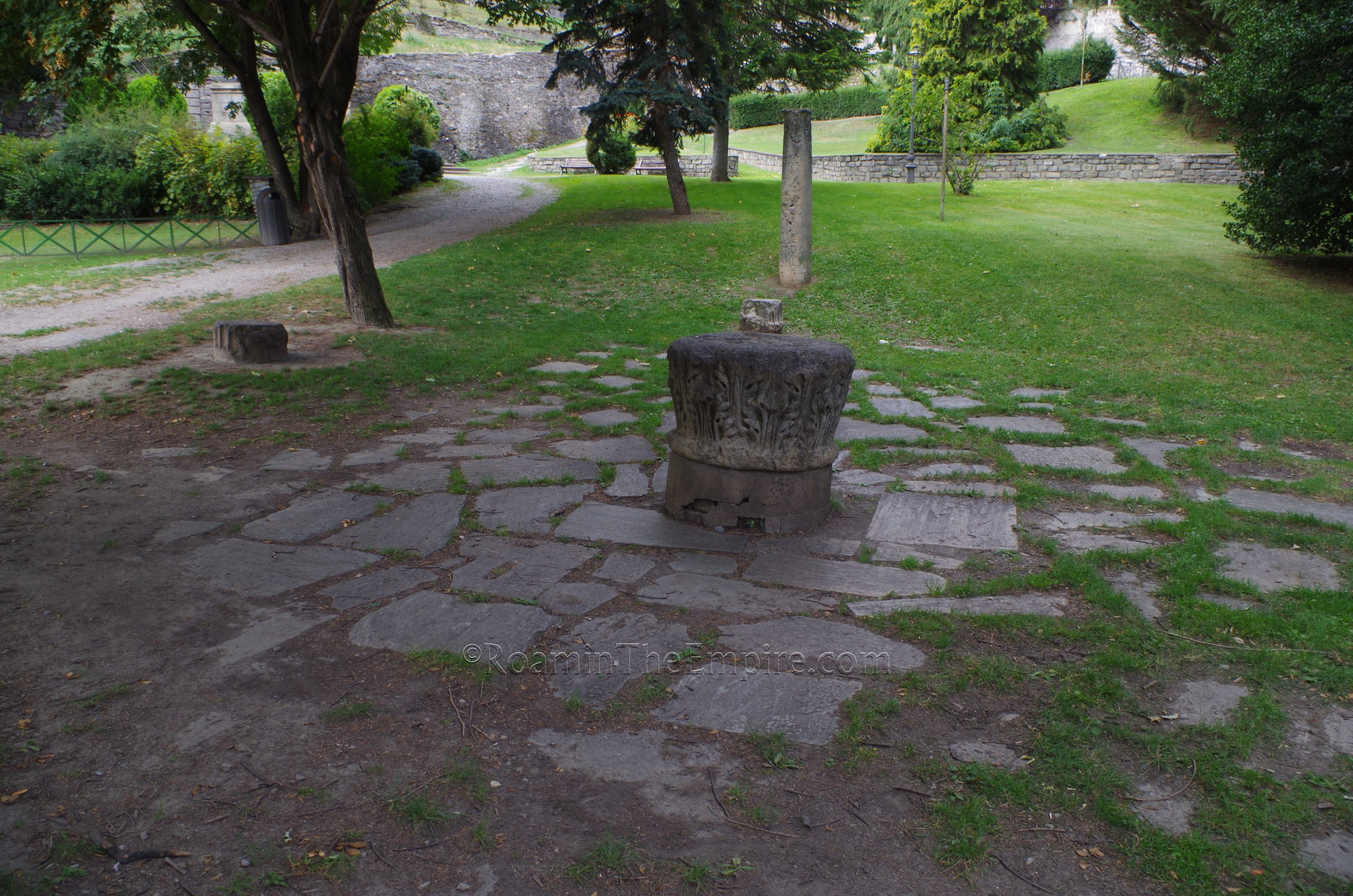
Essentially adjacent to the Porta Savoia is the Parco di Augusto, a public park that is open 24 hours a day with no restrictions in access. This area essentially serves as the approach to the Arch of Augustus and in antiquity was the area of the forum, but presently there isn’t really much to note here. At the south end of the park, though, there is a statue of Augustus (a modern copy of the Augustus Prima Porta) as well as some miscellaneous fragments of columns and capitals that appear to be ancient in origin, but don’t seem to be in situ or in any kind of arrangement related to the forum. There are some paving stones as well, but it is unclear if these are ancient paving stones from the forum or are more modern.
The park then slopes into a hill, upon which is the centerpiece of the remains at Susa, the Arch of Augustus. Like many of the other monuments in the city, this too is open access and can be visited at any time without restriction. There aren’t even any fences or barriers preventing direct access to the arch.
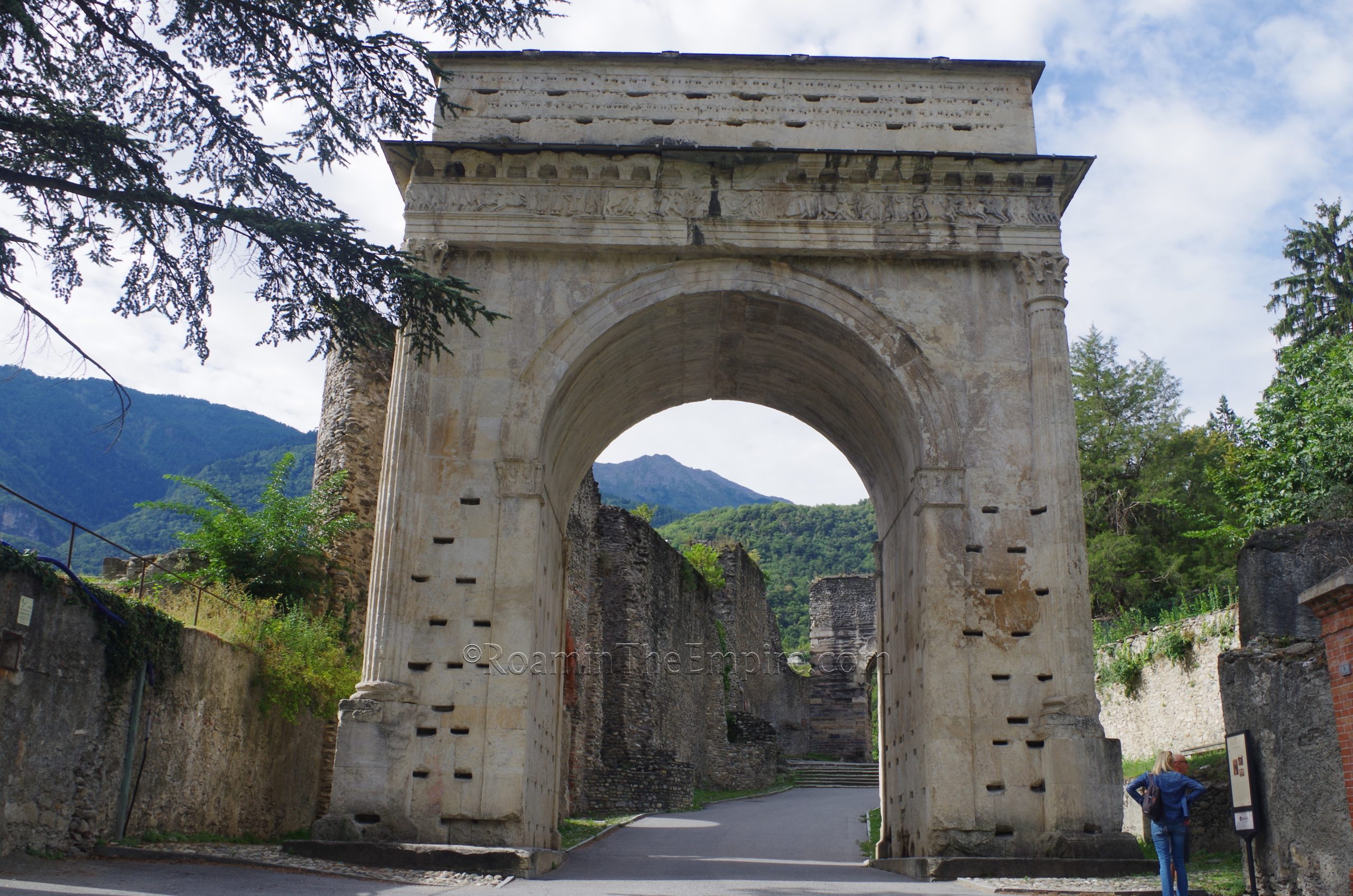
The Arch of Augustus was constructed sometime around 8 or 9 BCE by the elder Marcus Julius Cottius in honor of Augustus and recognizing the foedus relationship between the two. The bronze lettering of the inscriptions on either face of the arch have long since disappeared, but the letters are still partially inscribed on the stone, allowing the inscription to be reconstructed. Besides noting the purpose of the construction, the inscription also notes the 14 tribes that Cottius was given control of: the Segovii, Seusini, Belaci, Caturiges, Medulli, Tebavii, Adantes, Savincates, Ecdinii, Veaminii, Venisamores, Iemerii, Vesubianii, and Quadiates.
Below the inscription, a frieze decorates all four faces of the arch and depicts the signing of the treaty and a scene of a suovetaurilia sacrifice. The animals being sacrificed are, notably, much larger than the human figures in the scene. The numerous incisions in the face of the arch, particularly on the piers in in the area of the inscriptions, are the result of spoliation of the metal bindings used in the construction of the arch. There is a small informational sign in Italian and French on the north side of the arch.
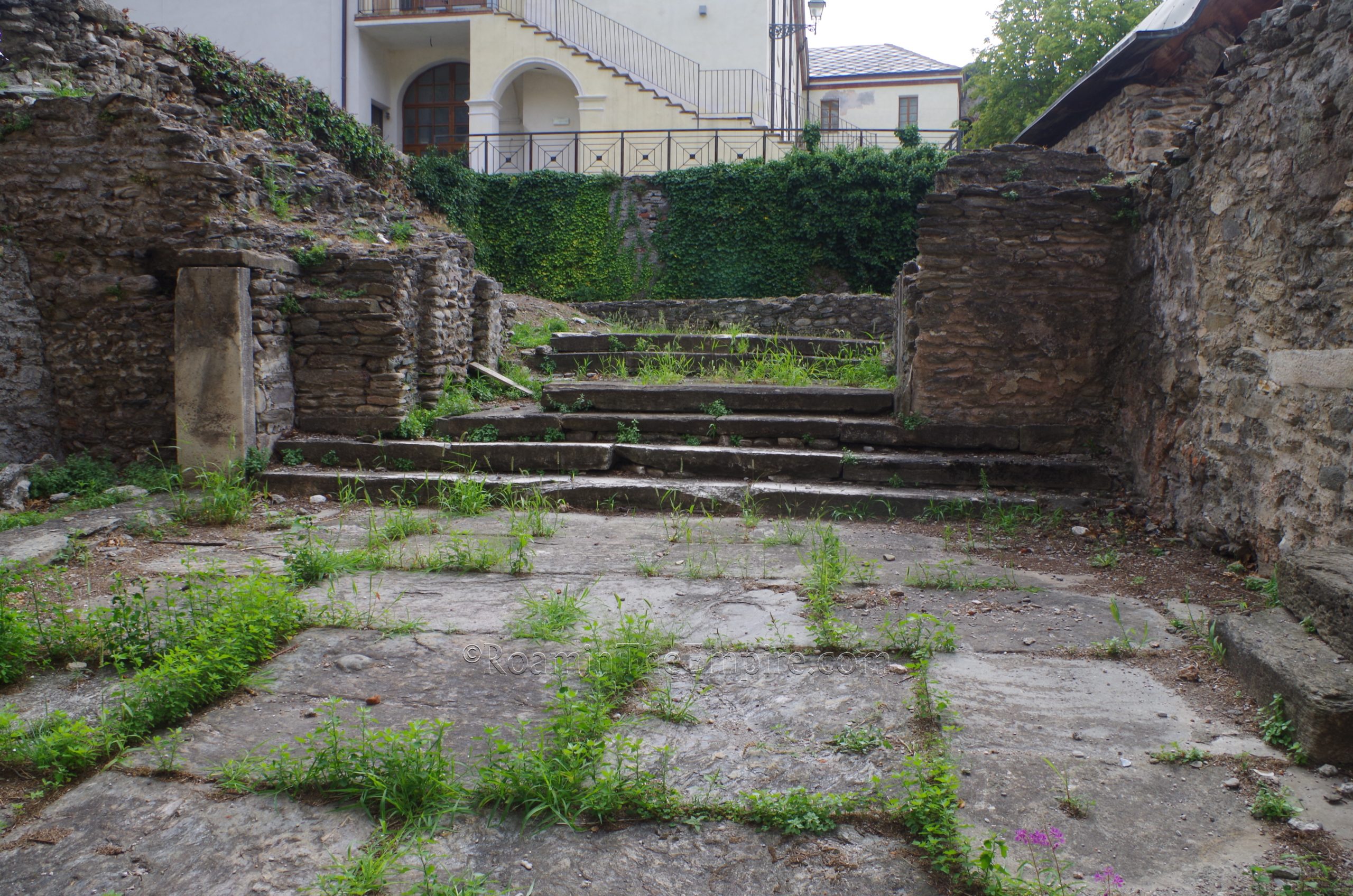
Just past the arch on the east side, some remains of the 1st to 4th century CE praetorium, the residence of the governor of Alpes Cottiae, is visible through a closed gate. These remains are also visible from the courtyard area of the Castello Contessa Adelaide, though there is no direct access to the remains. The gate near the arch will offer the closest and best view of the remains, but, the eastern angle from inside the courtyard (accessible just a few meters south past the aqueduct) offers some different perspectives. It’s hard to make out any real forms and there is no information present to contextualize any of what is here.
The previously mentioned aqueduct consists of a couple of arches spanning the path between two sets of later defensive walls associated with the castle. The presence of the aqueduct today owes itself to the incorporation into these defensive walls during the medieval period. The aqueduct was originally constructed in the 4th century CE, often linked with the construction of the Baths of Gratian, known from an inscription noting their construction during the reign of Gratian around 375 CE, but, there is little to suggest this aqueduct and the baths are linked in any way other than a general period of construction.
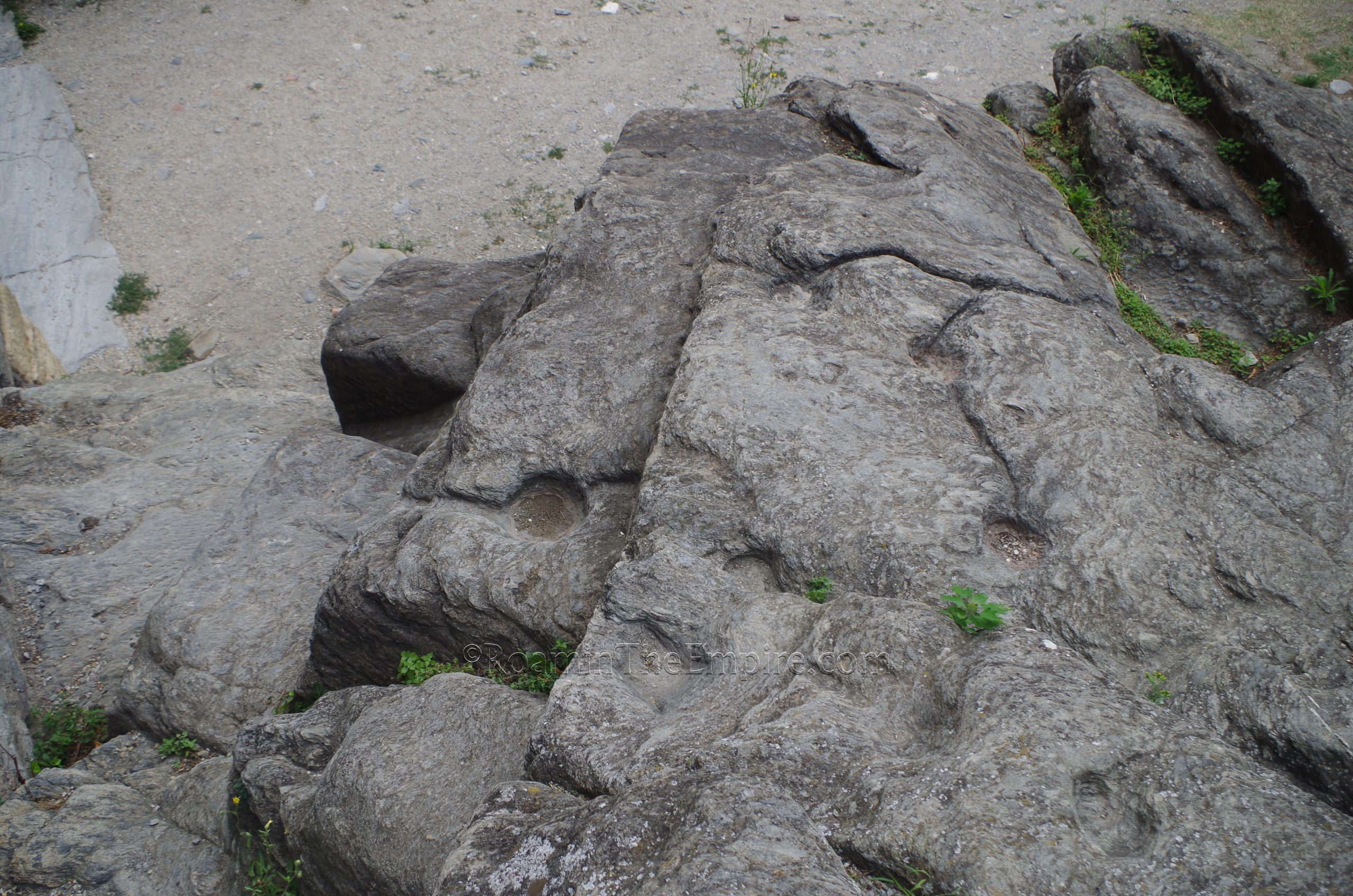
The middle pier of the aqueduct is built on a rocky outcropping, over which the western most arch spans. This outcropping bears signs of human intervention with linear cuts and shaping and has been identified as being a Celtic altar dating to perhaps as early as the 7th century BCE. The most interesting part of this are the small basin shaped incisions connected by channels, of which one theory is that these basins and channels were used to make divinations based on the flow of blood from a sacrifice made at the altar. The eye line of a person standing at the altar, too, lines up in elevation with the sacrificial scene of the Arch of Augustus about 50 meters down the hill. The altar was almost certainly still in use, or at least still maintained and visible, at the time of the construction of the arch and through most of the early imperial period. It seems only around the time of the construction of the aqueduct were attempts made to erase the existence of the altar, which would coincide with the Christian push to eliminate Pagan worship. A well near the aqueduct pier as well as a staircase cut into the rock near the altar that also date to the altar’s period of use.
In the adjacent Castello Contessa Adelaide, whose grounds contain the remains of the praetorium, is the Museo Civico. The hours of admission on opening days are from 10:00 to 13:00 and 14:00 to 18:00. Opening days vary with the time of year; in July and August from Tuesday through Sunday and the rest of the year on Friday through Sunday. Admission is 8 Euros.
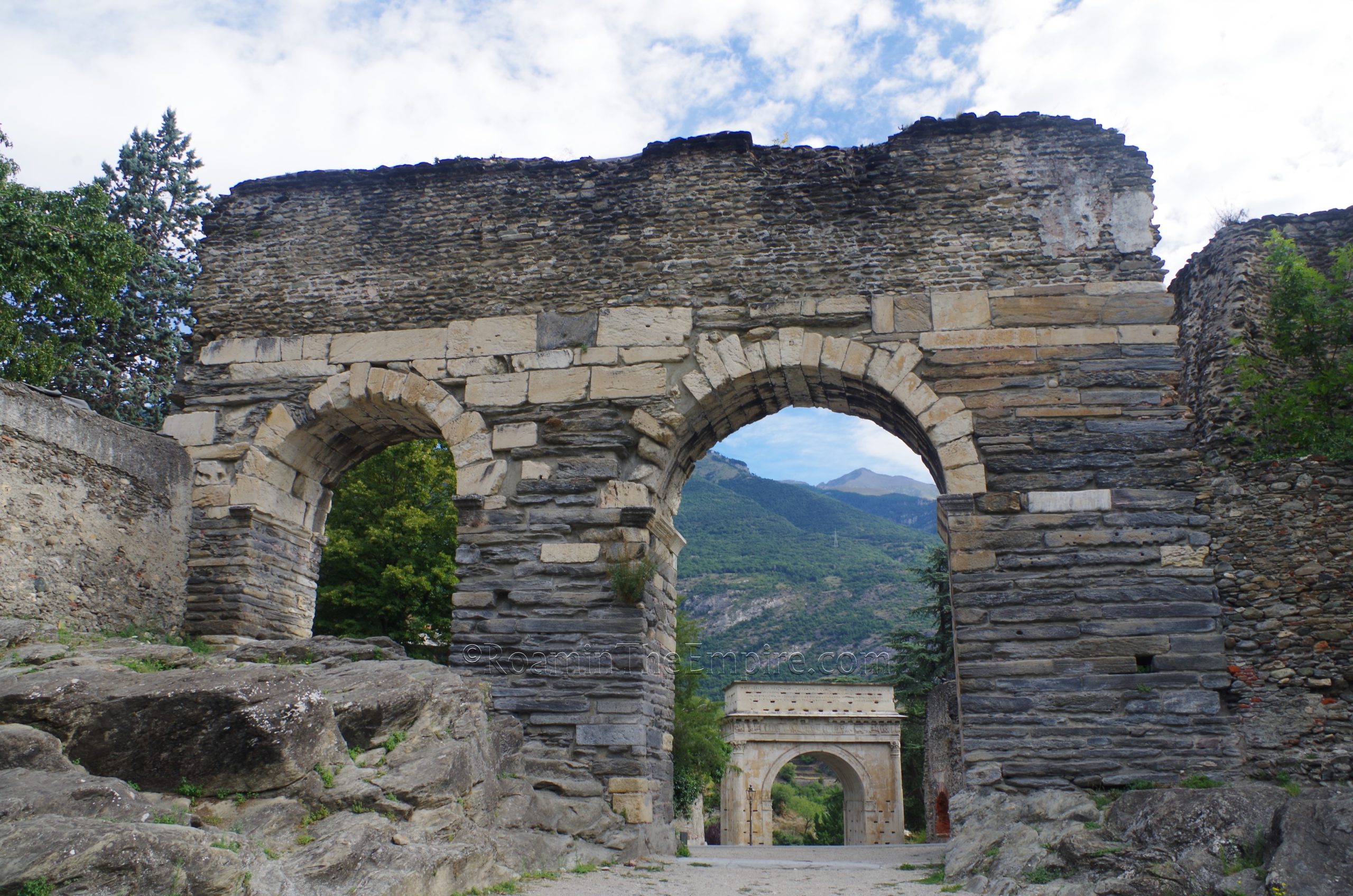
I visited the museum when it was still coming out of a long restoration project, and at the time, there was only a few rooms open and just a handful of ancient objects (mostly Egyptian) on display. Recent reviews make it seem like not a whole lot has changed on that front. The majority of objects on display through the museum date to post-antiquity periods. The most interesting part to me was the excavations in the floor of the castle, which reveal more elements of the praetorium through glass panels in the floor. There are a few interpretive signs in Italian that explain particular elements visible and the history of the excavation of those areas, as well as a couple general signs on Roman Segusium. I spent about a half an hour in the museum, so I thought the 8 Euro price was a bit steep. But, I also wasn’t focused on the castle itself or really much of the later material on display either.
Exiting down the hill on which the castle sits, toward the east, the path down leads onto Corso Unione Sovietica, there are a few points at which some remnants of the late 3rd or 4th century CE city walls can be seen on the north side of the street. One of these is the portal through which one passes from the path onto Corso Unone Sovietica, as a sign notes. There are two more points within about 150 meters as one heads eastward. The first is not specifically noted (at roughly about 24 Corso Unione Sovietica), but, that wall seems to be the exact same construction as the wall a little farther on (at roughly 16 Corso Unione Sovietica) that notes specifically the presence of the Roman wall that made up the southern circuit. The fourth point is actually on Via Norberto Rosa, at about number 10, as part of the eastern side of the city walls as the circuit turned northward. This too is specifically noted by a sign. All these sections of wall bear signs of later embellishments and renovations as they functioned into later periods.
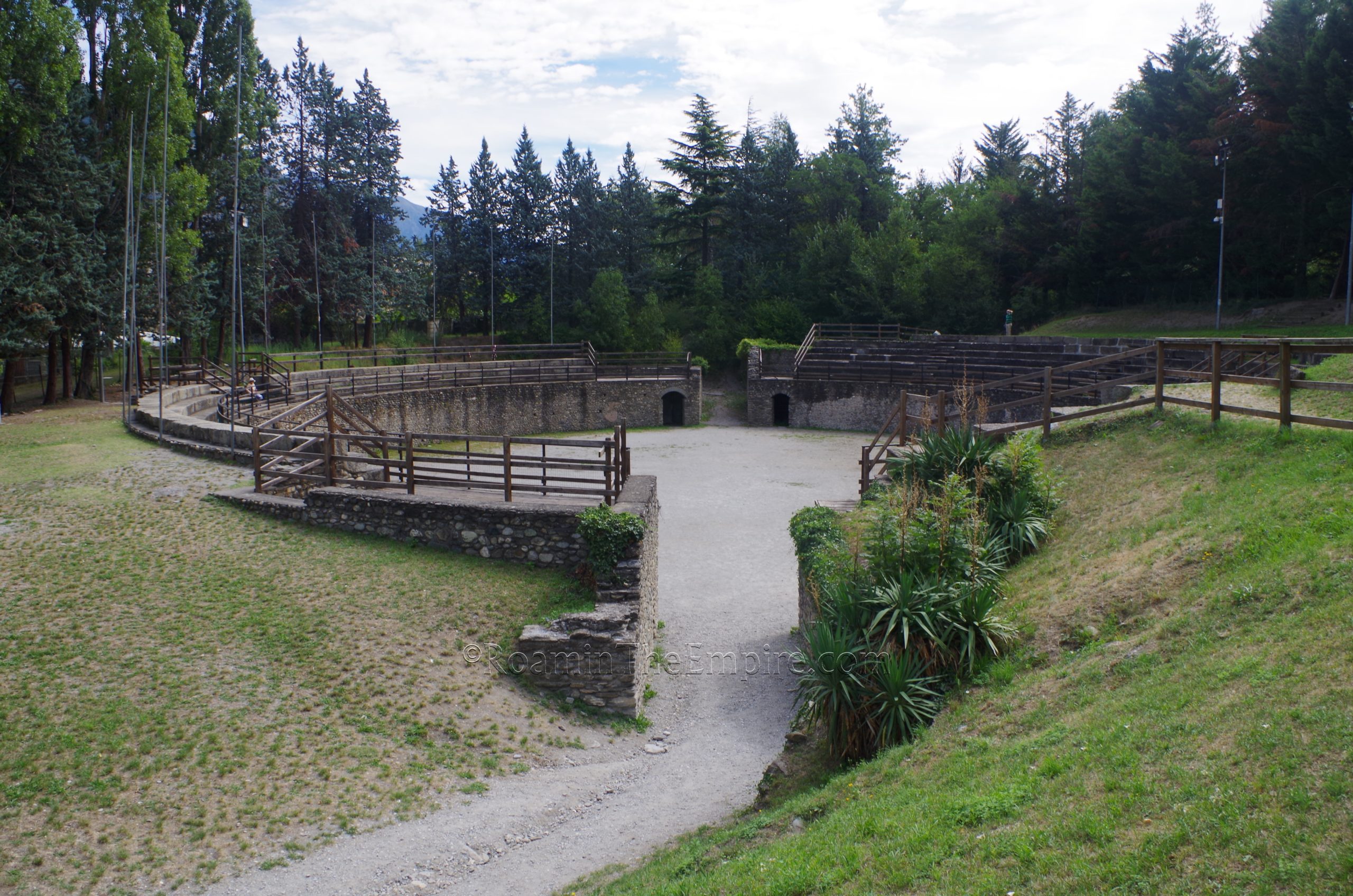
The final stop is at the southern edge of both the ancient and modern town; the amphitheater. The amphitheater is now a public park area, and as such is supposedly open 24 hours a day and has no admission or entrance restrictions. There is a gate that can restrict access to the area, though, so outside of normal daylight hours, there’s a chance it may be closed and inaccessible. The original construction of the amphitheater dates to the 2nd century CE, but the present form of it is very heavily reconstructed following its rediscovery in the late 1950’s. The amphitheater seems to have been in use until the late 5th century CE, when flooding seems to have precipitated its abandonment and subsequent burial by alluvial deposits.
All told, the remnants of ancient Segusium can be seen in about 2 hours, and given the transit time from Turin, it makes for an easy and enjoyable day trip among the mountains.
Sources:
Ammianus Marcellinus. Rerum Gestarum, 15.10.7.
Caranzano, Sandro. “. The Arch of Augustus in Susa. Architecture, Urban Planning and Visual Marks in the Augustan Propaganda.” Atti e Rassegna Tecnica, vol. 73, no. 1, Apr. 2019, pp. 9–21. Cassius Dio. Roman History, 60.24.4.
Odahl, Charles Matson. Constantine and the Christian Empire. London: Routledge, 2004.
Pliny the Elder. Historiae Naturalis, 3.24.
Pothecary, Sarah. “The European Provinces: Strabo as Evidence.” Edited by Daniela Dueck et al., Strabo’s Cultural Geography: The Making of a Kolossourgia. Cambridge: Cambridge University Press, 2005.
Ptolemy. Geographia, 3.1.
Smith, William. Dictionary of Greek and Roman Geography. Walton & Murray, 1870.
Stillwell, Richard, William L. MacDonald, and Marian Holland. McAllister. The Princeton Encyclopedia of Classical Sites. Princeton, NJ: Princeton U Press, 1976.
Strabo. Geographica, 4.6.6.
Suetonius. Life of Tiberius, 37.3.
Suetonius. Life of Nero. 18.


